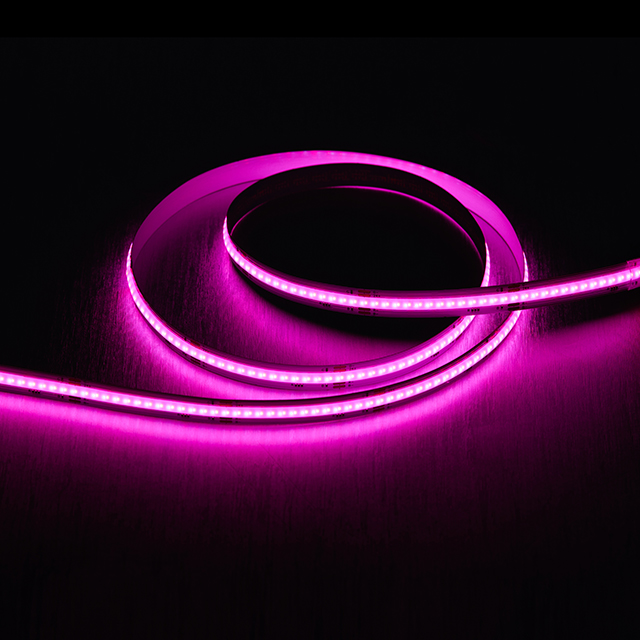Views: 0 Author: Site Editor Publish Time: 2025-03-14 Origin: Site
Are you concerned about your electricity bill? With rising energy costs, many people are switching to LED strips for their homes and businesses. LED strips are praised for being energy-efficient, but how much electricity do they really use?In this post, we’ll explore how much power LED strips consume and whether they live up to their reputation as an energy-saving option.
An LED strip is a flexible circuit board with surface-mounted light-emitting diodes (LEDs) attached. They are different from traditional bulbs because they don’t rely on filaments or gas-filled tubes to produce light. Instead, they use semiconductors to emit light when current flows through them. This makes them more energy-efficient than older lighting options.
LED strips are commonly used for accent lighting, task lighting, and even decorative purposes. They can be installed in various ways, making them a versatile lighting solution for homes and businesses.
There are different types of LED strips:
RGB LED strips: These strips can change colors, ideal for creating dynamic lighting effects.
Monochrome LED strips: These emit a single color, typically available in cool white or warm white.
Flexible LED strips: They are bendable, allowing for easy installation around corners or in tight spaces.
Smart LED strips: These strips can be controlled remotely using apps or voice assistants, offering additional features like dimming and color-changing.

When it comes to power consumption, LED strips are highly efficient. Compared to traditional incandescent bulbs, they use significantly less electricity to produce the same amount of light.
For example, a typical 60-watt incandescent bulb consumes 60 watts of electricity per hour. However, an LED strip that gives off the same amount of light as a 60-watt bulb uses only around 9-12 watts per hour.
| Light Type | Power Consumption (per hour) |
|---|---|
| 60-watt Incandescent Bulb | 60 watts |
| Equivalent LED Strip | 9-12 watts |
This stark difference in power usage highlights why LED strips are such an attractive option for reducing electricity costs. Even though they may have a higher initial cost, their energy efficiency leads to long-term savings.
In addition to consuming less energy, LED strips also last much longer than incandescent and fluorescent lights, further contributing to their overall cost-effectiveness.
The power consumption of LED strips varies depending on their type and length. Typically, the wattage is listed as power per meter. For example, many LED strips consume around 4-6 watts per meter.
A typical 16-foot LED strip can use around 36 watts per hour. This is equivalent to consuming about 0.036 kWh*per hour.
Here’s a quick look at the power consumption of some common LED strips:
| LED Strip Type | Power Consumption (per meter) |
|---|---|
| Standard LED Strip | 4-6 watts |
| High-density LED Strip | 10-12 watts |
| RGB LED Strip | 8-15 watts |
Residential Use: A common 10-meter LED strip in a home will typically use about 40-60 watts per hour, depending on the type. If you use it for about 5 hours a day, that’s 200-300 watt-hours daily.
Commercial Use: In office settings or larger spaces, LED strips may be installed in longer runs. A 20-meter strip used for 8 hours a day could consume around 160-240 watt-hours daily, depending on its wattage.
Yes, the brightness of LED strips directly affects how much power they consume. Brighter strips often consume more electricity.
Standard-density LED strips consume less power because they have fewer LEDs per meter.
High-density LED strips contain more LEDs, making them brighter but using more power.
For example:
A standard-density strip (4-6 watts per meter) is perfect for subtle accent lighting.
A high-density strip (10-12 watts per meter) is better for task lighting or bright spaces.
The total length of an LED strip plays a significant role in its energy consumption. Longer strips will naturally use more power because they have more LEDs. For example: A 5-meter LED strip using 6 watts per meter will consume about 30 watts per hour.
The density of LEDs in the strip also impacts its electricity usage. Low-density strips have fewer LEDs per meter and consume less power.High-density strips pack more LEDs into the same space, making them brighter and using more electricity.The brightness level of an LED strip directly affects its energy consumption. When you increase the brightness, it will use more power.
The color temperature of LED strips can also influence how much energy they use. Cool white LEDs typically consume slightly more energy than warm white LEDs. This is due to the differences in their light production processes. Some manufacturers design their products to use the same amount of power across different color temperatures, while others may vary.
To understand how much energy your LED strip uses, it's important to know a few key terms: watts and kilowatt-hours (kWh).
Watts (W) measure the amount of energy the LED strip uses per hour.
Kilowatt-hours (kWh) represent the total energy used over time. 1 kWh is equal to 1,000 watts used for one hour.
When you look at your LED strip’s label, you’ll usually see the wattage listed per meter or per foot. For example, a 5-meter strip might consume 40 watts, meaning it uses 40 watts of power each hour it's on.
To calculate the energy your LED strip uses, use this simple formula:
Power (W) x Time (hrs) / 1000 = kWh
Let’s calculate how much energy a 20-foot, 40-watt LED strip** uses in one day:
Power: 40 watts
Time: 5 hours/day
Formula: 40 watts x 5 hours / 1000 = 0.2 kWh/day
So, this 20-foot strip uses 0.2 kWh of energy each day.
LED strips are far more energy-efficient than traditional incandescent bulbs. A 60-watt incandescent bulb uses 60 watts per hour, while an LED strip producing the same light output uses only about 9-12 watts per hour.
By switching from incandescent to LED strips, you can save up to 80% on electricity. This means that for every hour your LED strip is on, it consumes significantly less power than an incandescent bulb.
| Light Type | Power Consumption (per hour) |
|---|---|
| 60-watt Incandescent Bulb | 60 watts |
| Equivalent LED Strip | 9-12 watts |
LED strips also outperform fluorescent lights in terms of energy efficiency. A typical 18-watt fluorescent bulb uses 18 watts per hour, while an LED strip that provides the same light level uses only 5-8 watts per hour.
Though fluorescent bulbs are more energy-efficient than incandescent bulbs, they still use more power than LED strips. LED strips are more cost-effective in the long run, due to their low energy consumption and longer lifespan.
| Light Type | Power Consumption (per hour) |
|---|---|
| 18-watt Fluorescent Bulb | 18 watts |
| Equivalent LED Strip | 5-8 watts |
LED strips are more energy-efficient because they convert a higher percentage of electricity into light, rather than heat. In contrast, incandescent and fluorescent bulbs waste a lot of energy as heat.
LED strips are known for their durability and low heat output, making them safe for extended use. Unlike incandescent bulbs, which generate a lot of heat, LED strips stay cool even when left on for long periods. This reduces the risk of overheating and fire hazards.LED strips are designed to last for up to 50,000 hours or more, which means you can leave them on for long periods without worrying about wear and tear. However, even though they are safe, you should still consider electricity consumption if you plan to leave them on continuously.
Leaving LED strips on for extended periods does impact your electricity bill. While LED strips are more energy-efficient than other lighting options, they still consume power. The longer they are on, the more energy they will use.
For instance, a 40-watt LED strip running 24/7 will use:
40 watts x 24 hours = 960 watts/day
960 watts/day x 30 days = 28.8 kWh/month
If you need to keep your LED strips on for long periods, consider these tips to save energy:
Use a timer: Set your LED strips to automatically turn off after a certain time.
Dim the lights: Reducing the brightness will lower power consumption.
Use motion sensors: Have the LED strip turn on only when needed.
Using LED strips wisely can help minimize their power consumption. One of the most effective strategies is to limit their use to areas where lighting is needed. For example:
Accent lighting: Use LED strips only for accent or decorative purposes instead of primary lighting.
Task lighting: Install LED strips in areas like workspaces or under cabinets where focused lighting is required.
Many LED strips come with dimming features or are compatible with smart controls. Dimming can significantly reduce power consumption by lowering the brightness level when full intensity isn’t needed.Smart LED strips, which can be controlled with apps or voice assistants, allow you to adjust brightnessor turn off the lights remotely. This flexibility ensures you use the lights only when necessary, further reducing energy usage.
In addition to dimming, motion sensors and timers are great ways to cut down on unnecessary power consumption.
Motion sensors automatically turn on LED strips when someone enters a room and turn them off when no movement is detected.
Timers let you set specific on/off times for your LED strips, ensuring they aren’t left on when not needed.
LED strips are highly energy-efficient lighting options, consuming significantly less electricity than traditional bulbs. They offer long-term savings due to their low power usage and long lifespan. By using smart controls, dimming, and motion sensors, you can further reduce energy consumption. Whether for home or business, LED strips provide a cost-effective solution for lighting needs without drastically increasing your electricity bill.
Q: Do LED strips use a lot of electricity?
A: No, LED strips are energy-efficient and consume far less electricity than traditional incandescent or fluorescent bulbs. For example, a 60-watt incandescent bulb uses 60 watts per hour, while an LED strip provides the same brightness using only 9-12 watts.
Q: Are LED strips cheaper to run than traditional light bulbs?
A: Yes, LED strips are cheaper to run. They use much less electricity compared to incandescent and fluorescent bulbs, resulting in lower monthly energy costs. A typical LED strip costs a fraction of the price to operate over time.
Q: Can LED strips increase my electricity bill?
A: While LED strips do consume electricity, their energy usage is minimal compared to older lighting options. For example, running a 40-watt LED strip for 24 hours a day only costs a few dollars per month.
INTEGRATE™ is a series of integrate flexible LED strips including single White, single Color, variable white, RGB, RGB pixel, RGBW and RGBVW. Various types would meet any your customized requirements. Integrate has dome surface as COB for soft and dot-less effect, same SMD technology as lighting sou
Flexible SMD LED strip lights have become one of the most popular lighting solutions in both residential and commercial environments. Their slim profile, low power consumption, and versatility make them suitable for accent lighting, task lighting, decorative installations, and even large-scale architectural illumination. Among the wide range of LED chips available today, SMD 3528 and SMD 5050 remain two of the most commonly used and widely recognized options.
SMD LED strip lights have become one of the most versatile and popular lighting solutions in modern homes, commercial environments, and creative projects. Their slim profile, flexible design, and energy efficiency make them ideal for accent lighting, task lighting, ambient illumination, and decorative installations. Yet one of the biggest questions users have—especially beginners—is whether SMD LED strip lights can be cut without damaging them.
LED strip lighting has become one of the most versatile and widely adopted solutions for modern residential, commercial, and architectural lighting. Among the different types of LED strips available today, SMD LED strip lights and COB LED strips are the two most popular choices. Each offers unique advantages, performance characteristics, and visual effects, making them suitable for different applications.
SMD LED strip lights have become one of the most versatile and widely used lighting solutions for residential, commercial, and industrial applications. From accent lighting in living rooms to large architectural installations and retail displays, LED strips offer flexibility, efficiency, and precise illumination control. However, managing long LED strips—especially those stretching beyond 5–10 meters—comes with unique challenges.
LED lighting has revolutionized the way homes, commercial spaces, and decorative environments are illuminated. Among the most popular modern lighting solutions, LED flexible strip lights stand out because they combine versatility, energy efficiency, and sleek aesthetics. Within this category, SMD LED strip lights have become the industry standard due to their compact size, strong brightness, and adaptability to a wide range of applications.
In the world of modern lighting, few products have transformed interior and exterior illumination as dramatically as SMD LED strip lights. Whether used for home decoration, retail ambiance, architectural highlights, or industrial applications, these flexible and efficient lighting tools offer unparalleled versatility. Their slim design, excellent brightness, and wide color options have made SMD LED strips a preferred choice for designers, homeowners, and engineers alike.
Light and color have long been understood to influence human emotions, behavior, and even physical well-being. From the moment we wake up to the time we go to sleep, the type of light surrounding us plays a vital role in shaping our moods, productivity, and overall state of mind. This is why understanding the psychology of light and color is crucial when selecting LED lighting for various environments, whether it's at home, in the office, or in commercial settings.
LED strip lights are a popular choice for modern lighting due to their energy efficiency, versatility, and sleek design. However, one crucial aspect that is often overlooked when using LED strips is thermal management. LED lights, like any other electronic component, generate heat as they operate, and if not properly managed, this heat can reduce their performance and lifespan.
Choosing the right LED strip lights for your home or office is a decision that requires careful consideration. LED strips have become an increasingly popular choice due to their versatility, energy efficiency, and aesthetic appeal. However, with so many options available on the market, it’s easy to feel overwhelmed by the number of different types and features.
Indirect lighting has become a popular choice for creating a soothing and stylish ambiance in both residential and commercial spaces. Unlike direct lighting, which often creates harsh shadows and bright spots, indirect lighting provides a more gentle and even illumination that enhances the atmosphere without overwhelming the eyes.
Proper lighting on boats or yachts is not just about enhancing the aesthetic appeal; it plays a crucial role in ensuring safety, functionality, and comfort on the water. Effective lighting can help improve visibility during nighttime navigation, set the mood for evening activities, and highlight specific areas of your vessel. One of the best lighting options for marine environments is LED strip lights. Their versatility, energy efficiency, and durability make them an excellent choice for a variety of marine applications.
To ensure that your LED strip lights continue to perform at their best and last as long as possible, proper care and installation are essential. LED strips are known for their longevity and energy efficiency, but several factors can influence how long they last. By following some simple yet effective maintenance tips, you can extend the lifespan of your LED strips and keep them running smoothly for years to come.
When purchasing LED strip lights for your home or business, you might notice various certifications listed on the product packaging or technical specifications. These certifications, often represented by logos or marks, indicate that the product has met specific safety, environmental, and quality standards. Understanding what these certifications mean can help you make informed decisions, ensuring you choose a reliable and safe lighting solution.
LED strip lights are a fantastic way to add vibrant lighting to your home or workspace, offering versatility and energy efficiency. However, when it comes to installation, there are common mistakes that many people make, which can negatively affect the performance, lifespan, and overall functionality of the LED strips. Whether you're a seasoned DIYer or a first-time installer, it's crucial to avoid these common errors to ensure your LED lights shine brightly and last for years to come.
Flexible lighting strips, commonly known as LED strips or tape lights, have revolutionized the way we illuminate spaces. Their adaptability, energy efficiency, and vibrant lighting options make them popular choices for a wide variety of applications—from home decor to commercial advertising and industrial uses.
In recent years, flexible lighting strips have become increasingly popular not just for indoor use, but also as a creative and practical solution for outdoor lighting applications.
Flexible LED strip lights have rapidly gained popularity in both residential and commercial lighting applications. Their versatility, energy efficiency, and ease of installation make them an excellent choice for accent lighting, decorative purposes, and practical illumination alike.
Flexible lighting strips, commonly known as LED strip lights, are thin, versatile lighting fixtures that consist of small light-emitting diodes (LEDs) mounted on a flexible circuit board.
In the world of modern lighting, flexible lighting strips—also known as LED strip lights or ribbon lights—have revolutionized how we illuminate spaces. These thin, adaptable lighting solutions offer not only energy efficiency but also unmatched versatility, making them a top choice for a wide range of residential, commercial, and industrial applications.


